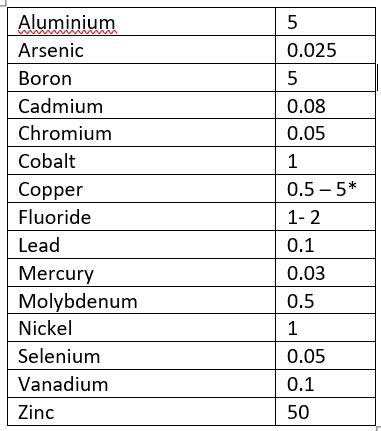Metals are ubiquitous in the environment and several of them can cause toxicity in the right circumstances. These include Arsenic, Cadmium, Copper, Iron, Lead, Mercury, Nickel, Selenium and Zinc. Several of these such as Selenium are also essential trace elements required in small amounts for normal health, growth, and productivity, and only become toxic at higher dose or exposure rates.
Exposure is most often via contaminated water supplies and pasture, or feed contaminated by chemicals such as herbicides, insecticides, fungicides, rodenticides etc. Lead from lead paint was formerly a common cause of poisoning but was phased out decades ago and is less likely now, though poisoning from lead accumulator batteries is still a potential risk. Selenium is widely used as a supplement and may be overdosed, especially if injectable forms are used in conjunction with dietary supplements. As contamination of water supplies is potentially significant, some water quality standards are shown below:
Upper concentration limits (in mg/ liter) of elements in drinking water potentially toxic to horses.
(Adapted from Canadian Council of Ministers of the Environment 2002)

*A lower limit for sheep & cattle and a higher limit for pigs & poultry.
Symptoms of toxicity vary widely with the metal involved and dose so veterinary advice should be sought if heavy metal poisoning is suspected.
